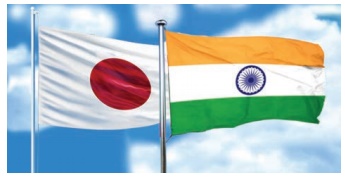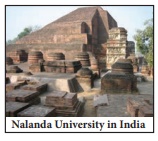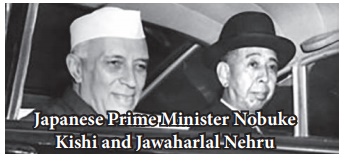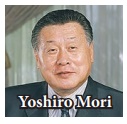Chapter: 12th Political Science : Chapter 9 : India and the World
India-Japan Relations
India-Japan Relations

History
The relations between India and Japan can be traced
back to the 6th century when Buddhism reached Japan. Historical
records indicate that scholars from Japan visited Nalanda University in India
and one of the most famous travellers was Tenjiku Tokubei. Tenjiku, is the
Japanese name for India, meaning ŌĆ£the heavenly abodeŌĆØ. The earliest political
exchange was established between Japan and the Portuguese colonies in India,
particularly Goa.

The Japan- India Association was set up in 1903,
post which the direct political exchanges began in the Meiji era (1868-1912).
Since then, the two countries have exchanged cultural, social, economic and
political ties.
Post Indian Independence
The diplomatic relations between the two countries
began with the signing of JapanŌĆÖs Peace Treaty with India in 1952, after the
end of World War II. India was one of the first countries to extend diplomatic
ties, with the invitation to the Asian Games held in New Delhi in 1951. The
relations were further strengthened by the mutual visits of Japanese Prime
Minister Nobuke Kishi and Jawaharlal Nehru. India became the first receipt of
JapanŌĆÖs yen loan and gradually emerged as IndiaŌĆÖs largest aid donor. Many
Indian political and economic thinkers praised Japanese economic rebuilding as
success after the war.

The relations between the two countries suffered a
setback during the cold war years, as Japan aligned with the United States
while India chose to adhere to Non-alignment policy. Further, the relations
were hampered when Japan took a neutral stand during the Sino-Indian border war
of 1962. While JapanŌĆÖs economic engagements with East and South-East Asian
nations deepened during the 1970s and 1980s, India was left outside the gamut
of the definitions of Asia. Japan also regarded nuclear tests by India as a
threat to its Non-Proliferation objective.

The relations started to improve with the visit of
Prime Minister Yoshiro Mori to India in 2000. There are dialogue mechanisms in
diverse fields such as economy, commerce, financial services, health, road
transport, shipping, education etc. to name a few sectors.
Economic Relations
Sony, Yamaha, Honda and Toyota have become
household names in India, with the setting up of their manufacturing facilities
in the country. SuzukiŌĆÖs partnership with the Indian automobile company -
Maruti Suzuki is one of the largest car manufacturers. JapanŌĆÖs support for
IndiaŌĆÖs efforts in economic development, in priority areas like power,
transportation, environmental projects and projects related to basic human
needs have been significant.
Prime Minister Yoshiro MoriŌĆÖs visit to India in
August 2000 provided the momentum to strengthen the Japan-India relationship.
Mr. Mori and Prime Minister Atal Bihari Vajpayee decided the establishment of
ŌĆ£Global Partnership between Japan and IndiaŌĆØ. Since Prime Minister Junichiro KoizumiŌĆÖs
visit to India in April 2005, Japan-India annual summit meetings have been held
in respective capitals. When Prime Minister Manmohan Singh visited Japan in
December 2006, Japan-India relationship was elevated to the ŌĆ£Global and
Strategic PartnershipŌĆØ.
Security Cooperation
During Prime Minister SinghŌĆÖs visit to Japan in
October 2008, two leaders issued ŌĆ£the Joint Declaration on Security Cooperation
between Japan and IndiaŌĆØ.
Japan signed the Declaration on Security
Cooperation with India in October 2008, only the third country with which to have
such a security relationship after the USAand Australia. This event sent a
positive message to the world community that Japan and India were keen on
strengthening their bilateral ties beyond cheque book diplomacy. The rise of
China also serves as a significant reason for the realignment of partnerships
in the region. Besides increasing the number of bilateral visits by the top
defence and military officials as a part of their ŌĆśstrategic and global
partnershipŌĆÖ, both are engaged in initiatives on maritime security, counter
terrorism, counter-proliferation, disaster management and energy security.
In September 2014, Prime Minister Narendra Modi
paid an official visit to Japan and had a summit meeting with Prime Minister
Shinzo Abe. In December 2015, Prime Minister Abe paid an official visit to India
and had a summit meeting with Prime Minister Narendra Modi. They announced
ŌĆ£Japan and India Vision 2025 Special Strategic and Global Partnership Working
Together for Peace and Prosperity of the Indo-Pacific Region and the WorldŌĆØ a
joint statement that would serve as a guide for the ŌĆ£new era in Japan-India
relations.ŌĆØ
In November 2016, Prime Minister Modi paid an
official visit to Japan and had a summit meeting with Prime Minister Abe. Prime
Minister Abe stated that this summit would lead the prosperity and stability of
the Indo-Pacific region as a result of coordinating the ŌĆ£Free and Open India
and Pacific StrategyŌĆØ and the ŌĆ£Act EastŌĆØ policy.
Japan expects India for improving the business
environment, including the easing of regulations and the stabilization of the
system. India established the ŌĆ£Japan PlusŌĆØ office in the Ministry of Commerce
and Industry in October 2014 as a ŌĆ£one-stopŌĆØ location for resolving problems
faced by Japanese companies. Japan and India agreed to set up 11 candidates of
Japanese industrial townships around DMIC and CBIC areas in April 2015. Prime
Minister Abe requested IndiaŌĆÖs early decision on introducing special incentive
packages in Japanese industrial townships in December 2015 and November 2016.
India decided to introduce the Shinkansen system in
December 2015, when Prime Minister Abe visited India. The JapanŌĆÖs Shinkansen
system is the highest class of High-Speed Railway systems around the world in
terms of its safety and accuracy. Japan and India confirmed that the general
consultant would start its work in December 2016 with the construction work to begin
in 2018, and the railway operation would commence in 2023.
India has been the largest recipient of Japanese
ODA loan in the past decades. Delhi Metro is one of the most successful
examples of Japanese cooperation through the utilization of ODA.
IndiaŌĆÖs primary exports to Japan have been
petroleum products, chemicals, elements, compounds, non-metallic mineral ware,
fish and fish preparations, metalliferous ores and scrap, clothing and
accessories, iron and steel products, textile yarn, fabrics and machinery etc.
IndiaŌĆÖs primary imports from Japan are machinery, transport equipment, iron and
steel, electronic goods, organic chemicals, machine tools, etc. Japanese FDI into
India has mainly been in automobile, electrical equipment, telecommunications,
chemical and pharmaceutical sectors.
In terms of human resource development in the
manufacturing sector in India, Japan announced its cooperation of training
30,000 Indian people over next 10 years in the Japan-India Institute for
Manufacturing (JIM), providing Japanese style manufacturing skills and
practices, in an effort to enhance IndiaŌĆÖs manufacturing industry base and
contribute to ŌĆ£Make in IndiaŌĆØ and ŌĆ£Skill IndiaŌĆØ Initiatives. JIM and the
Japanese Endowed Courses (JEC) in engineering colleges will be designated by
Japanese companies in India, and this is a good example of cooperation between
the public and private sectors. In summer 2017, the first four JIMs started in
the States of Gujarat, Karnataka, Rajasthan and Tamil Nadu, and the first JEC
was established in the State of Andhra Pradesh. Since then, four more JIMs and
one JEC have started. Those institutes are also expected to give more Indian
students the ambition to study the Japanese language.
Cultural Relations
The year 2012 marked the 60th anniversary of the
establishment of diplomatic relations between Japan and India. Various cultural
events took place both in Japan and in India to promote mutual understanding
between the two countries, under the theme of ŌĆ£Resurgent Japan, Vibrant India:
New Perspectives, New Exchanges.ŌĆØ
During the visit of our Prime Minister to Japan in
November 2016, the two Prime Ministers agreed to mark the year 2017 as the Year
of Japan-India Friendly Exchanges to further enhance people-to-people exchanges
between Japan and India.
Related Topics